headlights MAZDA MODEL CX-5 2018 (in English) User Guide
[x] Cancel search | Manufacturer: MAZDA, Model Year: 2018, Model line: MODEL CX-5, Model: MAZDA MODEL CX-5 2018Pages: 628, PDF Size: 82.38 MB
Page 192 of 628

•If the headlight switch and the
windshield wiper switch are in
,
and the wipers are operated at low or
high speed by the auto wiper control for
several seconds, bad weather conditions
are determined and the headlights may
be turned on.
•The auto-wiper control functions can be
turned off. Refer to Personalization
Features on page 9-9.
▼ Windshield Washer
Pull the lever toward
you and hold it to
spray washer fluid.
Washer
OFF
NOTE
If the windshield washer is turned on when
the windshield wipers are not operating,
the windshield wipers operate a few times.
If the washer does not work, inspect the
fluid level (page 6-20). If the fluid level
is normal, consult an Authorized Mazda
Dealer.
Rear Window Wiper and
Wa s h e r
The ignition must be switched ON to use
the wiper.
▼Rear Window Wiper
Turn the wiper on by turning the rear
wiper/washer switch.
Switch Posi-
tion Wiper operation
Stop
Intermittent
Normal
▼
Rear Window Washer
To spray washer fluid,
turn the rear wiper/
washer switch to either of the
position.
After the switch is released, the washer
will stop.
If the washer does no t work, inspect the
fluid level (page 6-20). If the fluid level
is normal and the washer still does not
work, consult an Authorized Mazda
Dealer.
When Driving
Switches and Controls
4-56
CX-5_8GN5-EA-17J_Edition1 2017-8-18 12:58:27
Page 223 of 628
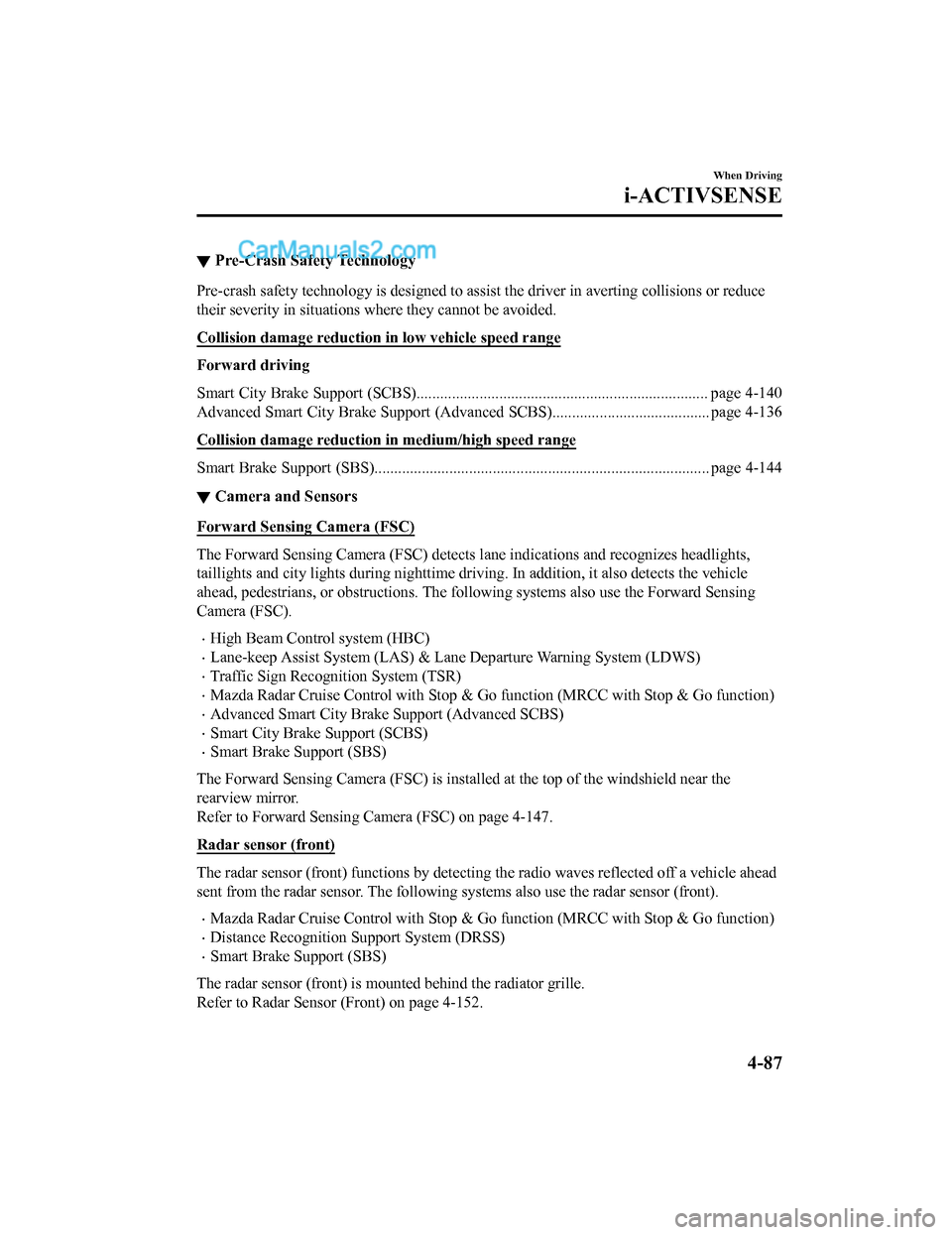
▼Pre-Crash Safety Technology
Pre-crash safety technology is de
signed to assist the driver in averting collisions or reduce
their severity in situations where they cannot be avoided.
Collision damage reduction in low vehicle speed range
Forward driving
Smart City Brake Support (SCBS)................................ .......................................... page 4-140
Advanced Smart City Brake Support (Advanced SCBS).............. .......................... page 4-136
Collision damage reduction in medium/high speed range
Smart Brake Support (SBS)...................................... ............................................... page 4-144
▼Camera and Sensors
Forward Sensing Camera (FSC)
The Forward Sensing Camera (FSC) detects lane indications and recognizes headlights,
taillights and city lights during
nighttime driving. In addition, it also detects the vehicle
ahead, pedestrians, or obstructi ons. The following systems also use the Forward Sensing
Camera (FSC).
•High Beam Control system (HBC)
•Lane-keep Assist System (LAS) & Lane Departure Warning System ( LDWS)
•Traffic Sign Recognition System (TSR)
•Mazda Radar Cruise Control with Stop & Go function (MRCC with S top & Go function)
•Advanced Smart City Brake Support (Advanced SCBS)
•Smart City Brake Support (SCBS)
•Smart Brake Support (SBS)
The Forward Sensing Camera (FSC) is installed at the top of the windshield near the
rearview mirror.
Refer to Forward Sensing Camera (FSC) on page 4-147.
Radar sensor (front)
The radar sensor (front) functions by detecting the radio waves reflected off a vehicle ahead
sent from the radar sensor. The following systems also use the radar sensor (front).
•Mazda Radar Cruise Control with Stop & Go function (MRCC with S top & Go function)
•Distance Recognition Support System (DRSS)
•Smart Brake Support (SBS)
The radar sensor (front) is mount ed behind the radiator grille.
Refer to Radar Sensor (Front) on page 4-152.
When Driving
i-ACTIVSENSE
4-87
CX-5_8GN5-EA-17J_Edition1 2017-8-18 12:58:27
Page 225 of 628

Adaptive Front Lighting System (AFS)*
The adaptive front lighting system (AFS) automatically adjusts the headlight beams to the
left or right in conjunction with the operation of the steering wheel after the headlights have
been turned on.
A system malfunction or operation conditions are indicated by a warning.
Refer to Warning/Indicator Lights on page 4-30.
NOTE
The Adaptive Front Lighting System (AFS) func tion can be switched to operable/inoperable
using the personalization function.
Refer to Personalization Features on page 9-9.
When Driving
i-ACTIVSENSE
*Some models.4-89
CX-5_8GN5-EA-17J_Edition1 2017-8-18 12:58:27
Page 226 of 628
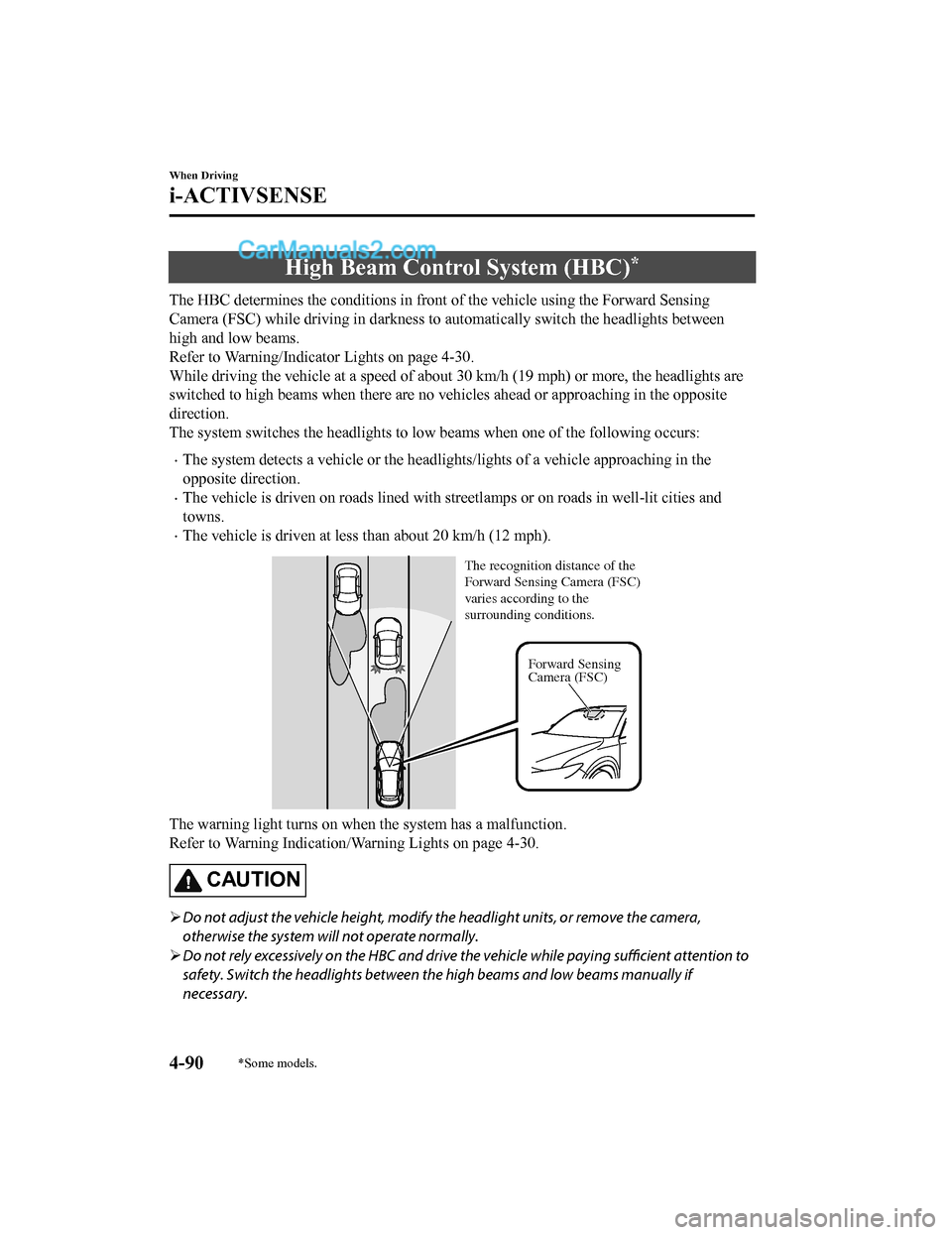
High Beam Control System (HBC)*
The HBC determines the conditions in front of the vehicle using the Forward Sensing
Camera (FSC) while driving in darkness to automatically switch the headlights between
high and low beams.
Refer to Warning/Indicator Lights on page 4-30.
While driving the vehicle at a speed of about 30 km/h (19 mph) or more, the headlights are
switched to high beams when there are no vehicles ahead or appr oaching in the opposite
direction.
The system switches the headlight s to low beams when one of the following occurs:
•The system detects a vehicle or the headlights/lights of a vehi cle approaching in the
opposite direction.
•The vehicle is driven on roads lined with streetlamps or on roa ds in well-lit cities and
towns.
•The vehicle is driven at less than about 20 km/h (12 mph).
Forward Sensing
Camera (FSC)
The recognition distance of the
Forward Sensing Camera (FSC)
varies according to the
surrounding conditions.
The warning light turns on when the system has a malfunction.
Refer to Warning Indication/Warning Lights on page 4-30.
CAUTION
Do not adjust the vehicle height, modify th e headlight units, or remove the camera,
otherwise the system will not operate normally.
Do not rely excessively on the HBC and drive the vehicle while paying
sufficient attention to
safety. Switch the headlights between the high beams and low beams manually if
necessary.
When Driving
i-ACTIVSENSE
4-90*Some models.
CX-5_8GN5-EA-17J_Edition1 2017-8-18 12:58:27
Page 227 of 628

NOTE
The timing in which the system switches the headlights changes under the following
conditions. If the system does not switch the headlights appropriately, manually switch
between high and low beams according to the visibility as well as road and traffic
conditions.
•When there are sources of light in the area such as street lamps, illuminated signboards,
and traffic signals.
•When there are reflective objects in the surrounding area such as reflective plates and
signs.
•When visibility is reduced under rain, snow and foggy conditions.
•When driving on roads with sharp turn or hilly terrain.
•When the headlights/rear lamps of vehicles in front of you or in the opposite lane are dim
or not illuminated.
•When there is sufficient darkness such as at dawn or dusk.
•When the luggage compartment is loaded with heavy objects or the rear passenger seats
are occupied.
•When visibility is reduced due to a vehicle in front of you spraying water from its tires
onto your windshield.
▼ To Operate the System
The HBC operates to s
witch the headlights
automatically between high and low
beams after the igni tion is switched ON
and the headlight sw itch is in the AUTO
and high beam position.
The HBC determines that it is dark based
on the brightness of the surrounding area.
At the same time, the HBC indicator light
(green) in the instrument cluster
illuminates.
The HBC determines that it is dark based
on the brightness of the surrounding area.
NOTE
•When the vehicle speed is about 30 km/h
(19 mph) or more, the headlights
automatically switch to high beams
when there are no vehicles ahead or
approaching in the opposite direction.
When the vehicle speed is less than
about 20 km/h (12 mph), the HBC
switches the headlights to low beams.
•The low beams may not switch to high
beams when cornering.
•Operation of the HBC function can be
disabled. Refer to Personalization
Features on page 9-9.
When Driving
i-ACTIVSENSE
4-91
CX-5_8GN5-EA-17J_Edition1 2017-8-18 12:58:27
Page 237 of 628
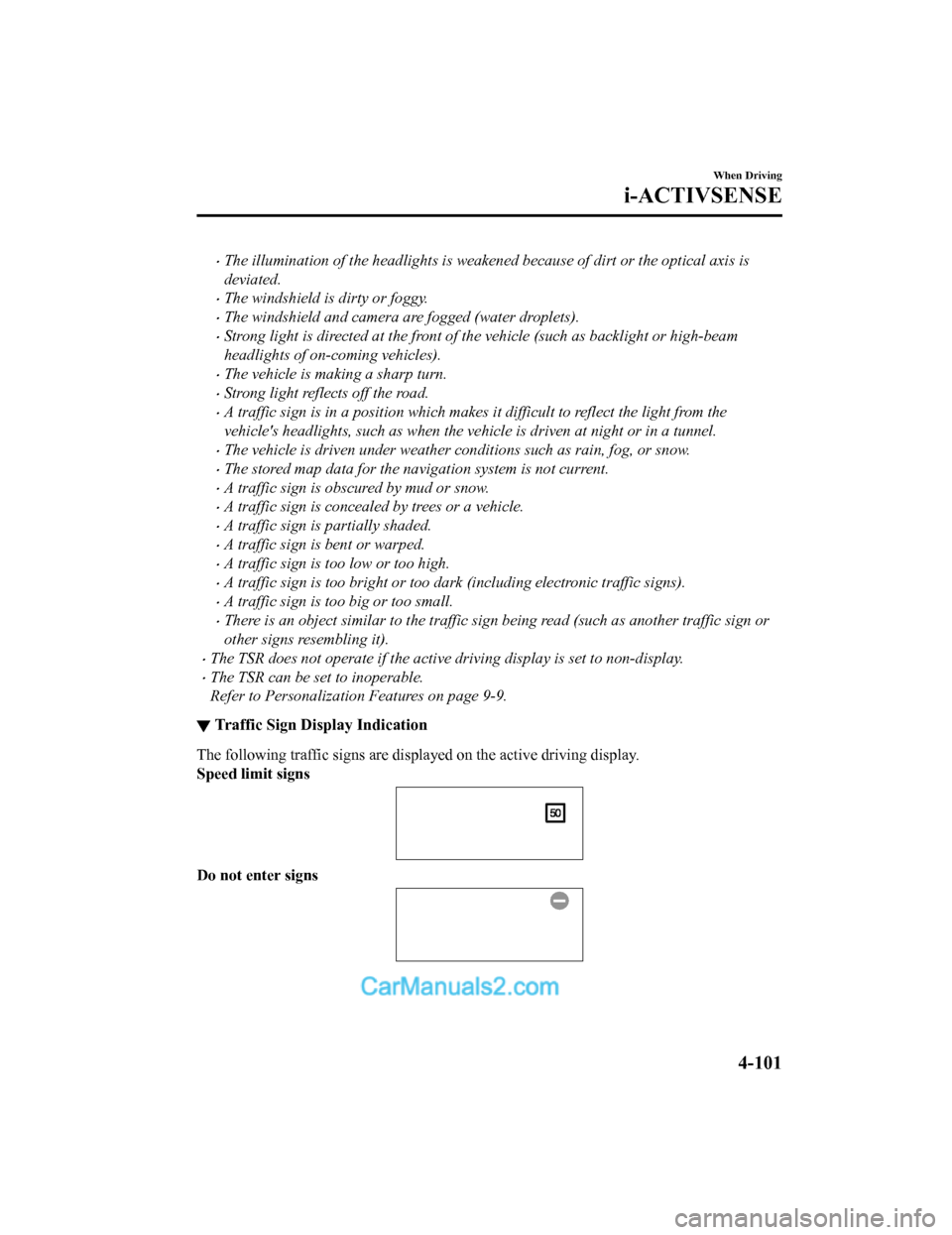
•The illumination of the headlights is weakened because of dirt or the optical axis is
deviated.
•The windshield is dirty or foggy.
•The windshield and camera are fogged (water droplets).
•Strong light is directed at the front of the vehicle (such as backlight or high-beam
headlights of on-coming vehicles).
•The vehicle is making a sharp turn.
•Strong light reflects off the road.
•A traffic sign is in a position which makes it difficult to reflect the light from the
vehicle's headlights, such as when the vehicle is driven at night or in a tunnel.
•The vehicle is driven under weather conditions such as rain, fog, or snow.
•The stored map data for the navigation system is not current.
•A traffic sign is obscured by mud or snow.
•A traffic sign is concealed by trees or a vehicle.
•A traffic sign is partially shaded.
•A traffic sign is bent or warped.
•A traffic sign is too low or too high.
•A traffic sign is too bright or too dark (including electronic traffic signs).
•A traffic sign is too big or too small.
•There is an object similar to the traffic sign being read (such as another traffic sign or
other signs resembling it).
•The TSR does not operate if the active driving display is set to non-display.
•The TSR can be set to inoperable.
Refer to Personalization Features on page 9-9.
▼Traffic Sign Display Indication
The following traffic signs are d
isplayed on the active driving display.
Speed limit signs
Do not enter signs
When Driving
i-ACTIVSENSE
4-101
CX-5_8GN5-EA-17J_Edition1 2017-8-18 12:58:27
Page 263 of 628

•Tires other than conventional tires are equipped.
•Vehicle is driven on an intersection or junction, or on a forked road.
•The white (yellow) lane lines are less visible because of dirt or fading/patchiness.
•A vehicle in front of your vehicle is running near a white (yellow) lane line making it
less visible.
•A white (yellow) lane line is less visible because of bad weather (rain, fog, or snow).
•The vehicle is driven on a temporary lane or section with a closed lane resulting from
construction where there may be multiple wh ite (yellow) lane lines or they are
interrupted.
•A misleading line is picked up on the road su ch as a temporary line for construction, or
because of shade, lingering snow, or grooves filled with water.
•The surrounding brightness suddenly changes such as when entering or exiting a
tunnel.
•The illumination of the headlights is weakened because of dirt or the optical axis is
deviated.
•The windshield is dirty or foggy.
•The windshield, camera is fogged (water droplets).
•Back-light is reflected off the road surface.
•The road surface is wet and shiny after rain, or there are puddles on the road.
•The shade of a guardrail parallel to a white (yellow) lane line is cast on the road.
•The width of the driving lane is narrow or wide.
•Driving on roads with tight curves.
•The road is excessively uneven.
•The vehicle is shaken after hitting a road bump.
•There are two or more adjacent white (yellow) lane lines.
•There are various road markings or lane markings of various shapes near an
intersection.
When Driving
i-ACTIVSENSE
4-127
CX-5_8GN5-EA-17J_Edition1 2017-8-18 12:58:27
Page 285 of 628
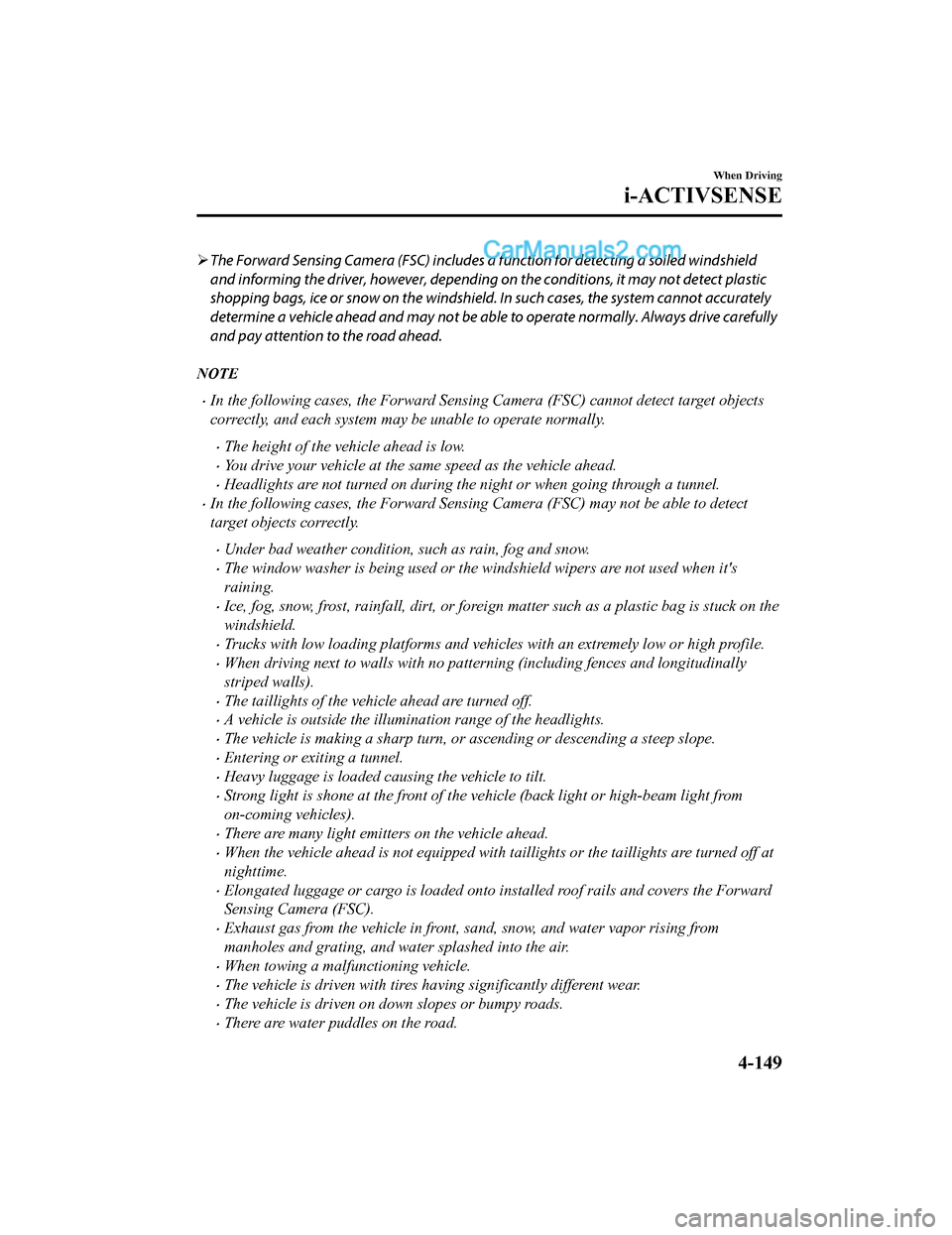
The Forward Sensing Camera (FSC) includes a function for detecting a soiled windshield
and informing the driver, however, depending on the conditions, it may not detect plastic
shopping bags, ice or snow on the windshield . In such cases, the system cannot accurately
determine a vehicle ahead and may not be able to operate normally. Always drive carefully
and pay attention to the road ahead.
NOTE
•In the following cases, the Forward Sensing Camera (FSC) cannot detect target objects
correctly, and each system may be unable to operate normally.
•The height of the vehicle ahead is low.
•You drive your vehicle at the same speed as the vehicle ahead.
•Headlights are not turned on during the night or when going through a tunnel.
•In the following cases, the Forward Sensing Camera (FSC) may not be able to detect
target objects correctly.
•Under bad weather condition, such as rain, fog and snow.
•The window washer is being used or the windshield wipers are not used when it's
raining.
•Ice, fog, snow, frost, rainfall, dirt, or foreign matter such as a plastic bag is stuck on the
windshield.
•Trucks with low loading platforms and vehicl es with an extremely low or high profile.
•When driving next to walls with no patterning (including fences and longitudinally
striped walls).
•The taillights of the vehicle ahead are turned off.
•A vehicle is outside the illumi nation range of the headlights.
•The vehicle is making a sharp turn, or ascending or descending a steep slope.
•Entering or exiting a tunnel.
•Heavy luggage is loaded causing the vehicle to tilt.
•Strong light is shone at the front of the vehicle (back light or high-beam light from
on-coming vehicles).
•There are many light emitters on the vehicle ahead.
•When the vehicle ahead is not equipped with taillights or the taillights are turned off at
nighttime.
•Elongated luggage or cargo is loaded onto installed roof rails and covers the Forward
Sensing Camera (FSC).
•Exhaust gas from the vehicle in front, sand, snow, and water vapor rising from
manholes and grating, and water splashed into the air.
•When towing a malfunctioning vehicle.
•The vehicle is driven with tires having significantly different wear.
•The vehicle is driven on down slopes or bumpy roads.
•There are water puddles on the road.
When Driving
i-ACTIVSENSE
4-149
CX-5_8GN5-EA-17J_Edition1 2017-8-18 12:58:27
Page 286 of 628

•The surroundings are dark such as during the night, early evening, or early morning, or
in a tunnel or indoor parking lot.
•The illumination brightness of the headlights is reduced or the headlight illumination is
weakened due to dirt or a deviated optical axis.
•The target object enters the blind spot of the Forward Sensing Camera (FSC).
•A person or object bursts onto the road from the shoulder or cuts right in front of you.
•You change lanes and approach a vehicle ahead.
•When driving extremely close to the target object.
•Tire chains or a temporary spare tire is installed.
•The vehicle ahead has a special shape. For example, a vehicle towing a trailer house or
a boat, or a vehicle carrier carrying a vehicle with its front pointed rearward.
•If the Forward Sensing Camera (FSC) cannot operate normally due to backlight or fog,
the system functions related to the Forward Sensing Camera (FSC) are temporarily
stopped and the following warn ing lights turn on. However, this does not indicate a
malfunction.
•High Beam Control System (HBC) warning light (amber)
•Lane-keep Assist System (LAS) & Lane Departure Warning System (LDWS) warning
indication
•Mazda Radar Cruise Control with Stop & Go function (MRCC with Stop & Go
function) warning indication
•Smart Brake Support/Smart City Brake Support (SBS/SCBS) warning indication/
warning light (amber)
•If the Forward Sensing Camera (FSC) cannot operate normally due to high temperatures,
the system functions related to the Forward Sensing Camera (FSC) are temporarily
stopped and the following warn ing lights turn on. However, this does not indicate a
malfunction. Cool down the area around the Forward Sensing Camera (FSC) such as by
turning on the air conditioner.
•High Beam Control System (HBC) warning light (amber)
•Lane-keep Assist System (LAS) & Lane Departure Warning System (LDWS) warning
indication
•Mazda Radar Cruise Control with Stop & Go function (MRCC with Stop & Go
function) warning indication
•Smart Brake Support/Smart City Brake Support (SBS/SCBS) warning indication/
warning light (amber)
When Driving
i-ACTIVSENSE
4-150
CX-5_8GN5-EA-17J_Edition1 2017-8-18 12:58:27
Page 486 of 628
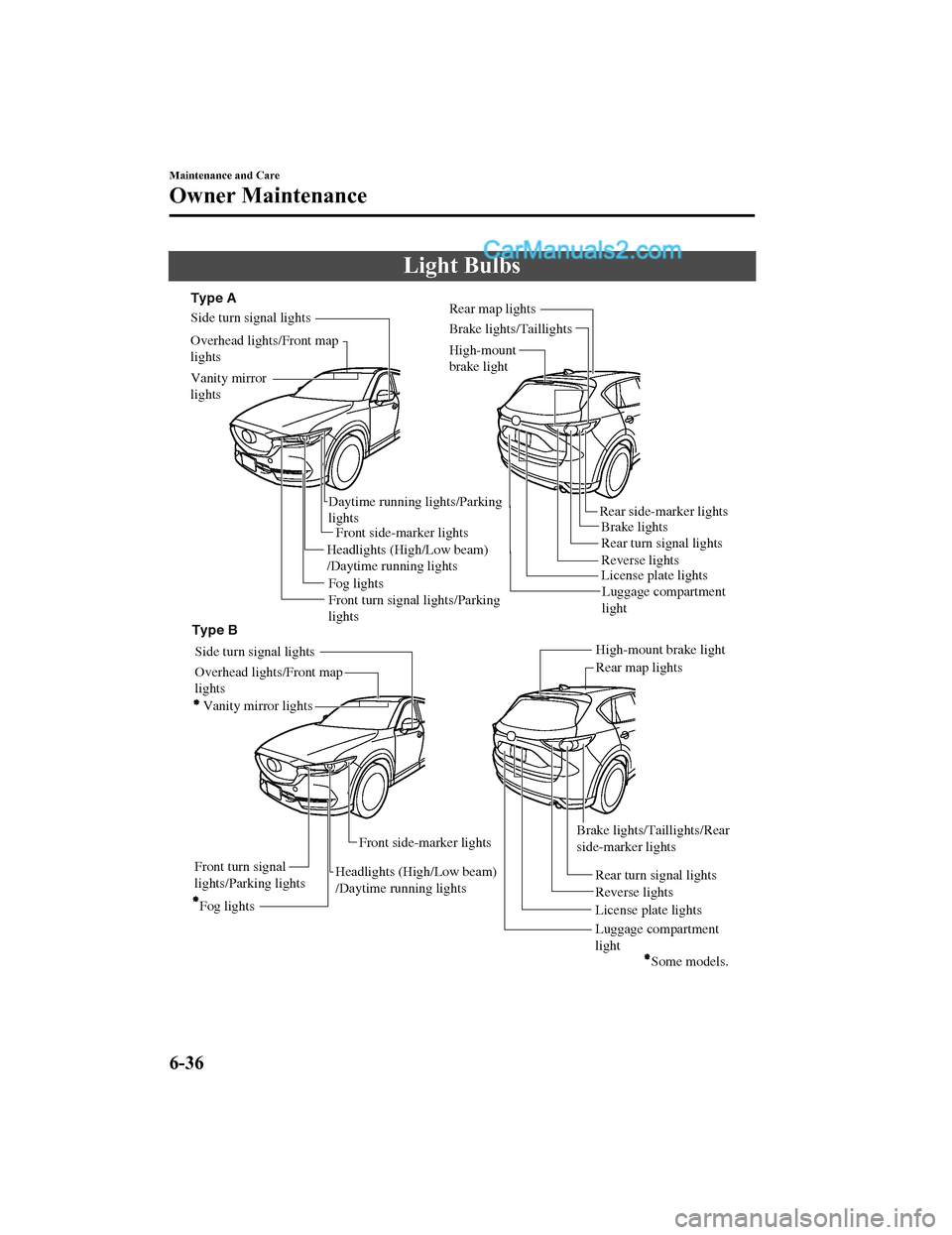
Light Bulbs
Side turn signal lights
Vanity mirror
lights Type A
Type B
Overhead lights/Front map
lights
Side turn signal lights Vanity mirror lights
Overhead lights/Front map
lights Front turn signal lights/Parking
lights
Rear turn signal lights
License plate lights Luggage compartment
light
Reverse lights
Brake lights/Taillights
Brake lights
High-mount
brake light Rear map lights
Rear turn signal lights
License plate lights
Luggage compartment
lightReverse lights
Brake lights/Taillights/Rear
side-marker lights High-mount brake light
Rear map lights
Fog lights
Headlights (High/Low beam)
/Daytime running lights
Front side-marker lights
Rear side-marker lights
Daytime running lights/Parking
lights
Front turn signal
lights/Parking lights Fog lights Front side-marker lights
Some models.
Headlights (High/Low beam)
/Daytime running lights
Maintenance and Care
Owner Maintenance
6-36
CX-5_8GN5-EA-17J_Edition1
2017-8-18 12:58:27